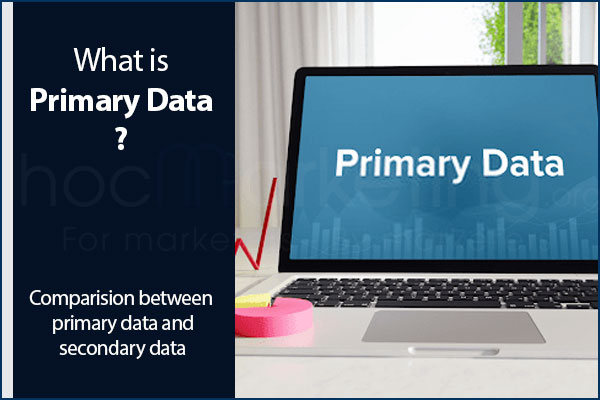
What is primary data? Comparision between primary data and secondary data

Data is the backbone of marketing research. Data can be divided into 2 categories: primary data and secondary data. Primary data is the most up-to-date research that is conducted for marketing purposes. This blog post will explain what primary data is and how to collect them in a marketing research.
Data is the backbone of marketing research. Marketing researchers use data from consumer surveys and interviews to create reports that are used by companies to help them understand what customers want or need. Data can be divided into 2 categories: primary data and secondary data. Primary data is the most up-to-date research that is conducted for marketing purposes. This blog post will explain what primary data is and how to collect them in a marketing research.
What is primary data?
Primary data is the newest, most relevant information that marketing researchers can use to help create market research reports. The data acquired from primary research is collected specifically for the purpose of marketing research. The data that companies use comes directly from individual consumers. Primary data can be collected through personal interviews and surveys.
Characteristics of primary data
Primary data have some distinctive characteristics
Primary data is collected for a specific purpose.
Primary data is always collected for a specific purpose in a marketing research. The data being collected will be used to answer specific questions that can help a company. (see How do marketing researchers use primary research)
Primary data contains information that is most relevant and up-to-date.
The newest information for marketing research comes directly from individual consumers. Primary data can help take a company in the right direction and give them insight on what the customer wants or needs.
The information does not need to be reorganized or adjusted because it is already in the correct form.
Market researchers do not need to organize or adjust survey responses for primary data. Market researchers are able to use the information that they are given in the correct form.
It may also contain new findings, facts and statistics that have not yet been discovered.
Many companies are able to use primary data to help them discover new facts and statistics about the consumer that they were not aware of before.
Primary data is collected directly from the source.
Primary data is the most accurate information marketers can use because of where it comes from. Market research reports are created using survey responses from individuals for their specific demographics and psychographics, which gives a more accurate depiction of what they really think about a product or service.
Primary data reflects the diversity in a population's views and opinions.
Primary data provides a wide range of different perspectives from individuals from various demographics and psychographics. Some databases contain more than 1 million respondents, which is more than what secondary data can provide.
Comparision between primary data and secondary data
Primary data
- collected for a specific purpose
- contain new facts and statistics that have not yet been discovered
- more accurate depiction of what they really think about a product or service
- diverse in views and opinions
- higher cost to collect
- take long time to collect
Secondary Data
- collected for many different purposes
- information may not be relevant or up-to-date
- lower cost to collect
- take short time to collect
Why do many marketers need primary data in a marketing research?
Marketers need primary data in a marketing research so they can create reports about what customers want or need. They are able to use the information given directly from the source, which makes it more accurate for market research. Marketers are also able to discover new facts and statistics that were not known before through primary data. Since primary data is the newest information marketers can use to help them know their customers better so they can create a product or service that is needed.
How do marketing researchers use primary research?
Marketers use primary research for many different things such as:
-To assess current attitudes and behaviors of consumers related to a particular brand, category, or issue.
-To identify consumer needs and problems.
-To study the sales potential of a product or service.
-To develop effective advertising, branding, or positioning strategies.
-To improve understanding of ad recall and brand awareness in relation to competitors and category users.
Primary research can be used for many different purposes in marketing and help marketers better understand their consumers to create a product or service that is needed.
Ways to collect primary data
Primary data can be collected in any number of different ways. Some examples of how to collect primary data for a marketing research include:
Personal Interviews
Personal interviews are conducted with consumers that have been selected by the market researchers. The information given directly from the consumer is kept confidential and cannot be shared with anyone else except for the market researchers.
Online Surveys
Market researchers will create their own online surveys and send them to consumers selected by the marketing research team. Once a consumer responds to the survey, his or her answers are kept confidential and only given to the marketing research team.
Focus Groups
Focus groups can be conducted in person or online. A group of consumers is selected by the market researchers to answer questions about the product or service that is being studied. Focus groups are a very effective way of collecting primary data because it is easy to have discussions with all the participants at once, which saves time for both parties.
Observation Studies
The most common examples of observation studies are often conducted at shopping malls, grocery stores or any other location where consumers purchase goods. The market researchers observe the shoppers and see how they behave when purchasing items to get an idea of what products or services they need or want.
Conclusion
Primary Data is the most accurate information marketers can use because of where it comes from. Market research reports are created using survey responses from individuals for their specific demographics and psychographics, which gives a more accurate depiction of what they really think about a product or service. Primary data provides a wide range of different perspectives from individuals from various demographics and psychographics. Some databases contain more than 1 million respondents, which is more than what secondary data can provide. Primary Data also has many benefits that come with being collected directly form the source including less cost to collect, higher accuracy in depicting thoughts on products/services as well as having diversity found within each demographic group surveyed making them highly valuable when considering new marketing strategies or ideas for your business's future success!











